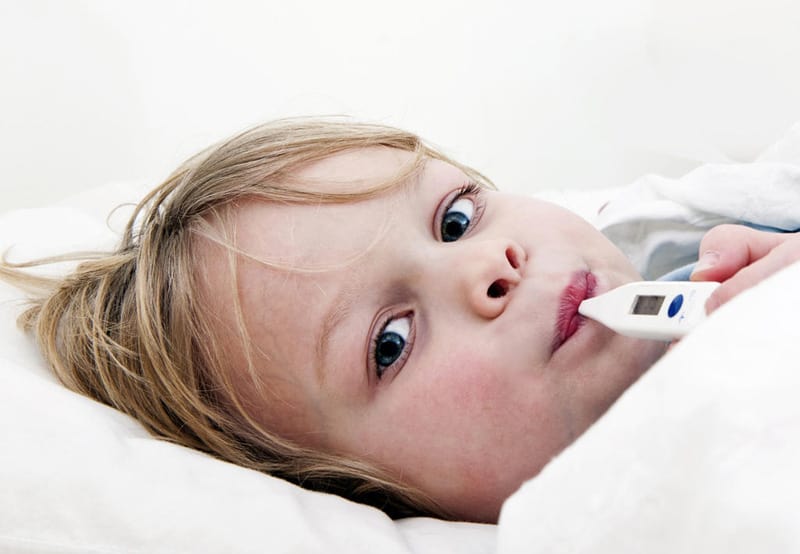
Ask Nurse Judy: All About Fevers
Written by Judy Kivowitz
Photography by Photo Via Babycenter
The seen-it-all, treated-it-all Nurse Judy Kivowitz of San Francisco’s Noe Valley Pediatrics shares her advice on common child health and behavioral conundrums.
FEVER FACTS:
-Fevers turn on the body’s immune system. They are one of our body’s protective mechanisms.
-Many fevers can actually help the body fight infection.
-Fevers that are associated with most viral syndromes and infections don’t cause brain damage. Our brain’s natural thermostat will not allow a fever to go over 105°F or 106°F.
-Only body temperatures higher than 108°F (42.2°C) can cause brain damage. Fevers only go this high with high environmental temperatures (e.g. someone confined in a closed car).
TRACKING A FEVER:
There are so many methods out there for measuring a body temperature. I personally don’t feel the need to invest in any expensive thermometers. I am generally quite satisfied with a digital underarm reading. The important thing is that however you take it, your thermometer seems accurate. Test it on yourself or other family members and take your child’s temp when he or she is healthy to make sure you trust it.
One of my favorite brands is Becton Dickinson. These are reasonably inexpensive and have been reliable in my experience. If you have one of the new ear or temporal scanning ones, feel free to keep using that. Sometimes the “high” readings on those seem a little higher than I believe to be accurate. Don’t ever let a number freak you out.
Temperatures can be measured in either Fahrenheit or Celsius. Here is a quick conversion chart that might come in handy:
98.6°F = 37°C
99.5°F = 37.5°C
100.0°F = 37.8°C
100.4°F = 38°C
101°F = 38.4°C
102°F = 38.9°C
103°F = 39.5°C
104°F = 40°C
105°F = 40.6°C
*For this article, I will be referring to the temperatures on the Fahrenheit scale.
WHEN YOU NEED TO WORRY:
For any child older than 2 months, as long as your child is active and happy, I generally don’t feel the need to “treat” a fever unless it is over 101.5 or so.
Parent’s often ask me, “When do we need to worry about a fever?” I am always more interested in your child’s overall mood and behavior than I am in any specific number on a thermometer. I am much more concerned about the lethargic, whimpering child who has a 99 temperature than I am the singing child with 104. But I do have a general rule about fevers.
If the fever is over 102 (it doesn’t matter how you measure, just be consistent) do the following:
-Treat it with a proper dose of Acetaminophen or Ibuprofen.
-Do a tepid bath or place cool compresses on the forehead and insides of the elbows and neck.
-Get your kid drinking. Little sips at a time are fine. Popsicles and ice chips are good for older kids.
-Recheck the temp in 45-60 minutes. If it is still over 102 and hasn’t budged at all, that is a fever that I am concerned about. It’s time to get your child seen.
SEIZURES AND SHAKES:
When children are in the process of spiking a fever, it is not uncommon for them to tremble and look shaky. When fevers are breaking, it is common to have lots of sweating. One of the more frightening aspects of a fever can be a febrile seizure. About 4% of children will have these. Febrile seizures are scary to watch, but they usually stop within 5 minutes. They cause no permanent harm. Watching your child have a seizure has been reported as the scariest experience ever. But knowing that they do happen once in a while and are generally harmless should help ease the terror. If your child is having a seizure they may have large jerky motions and their eyes may roll back. Your job is to stay calm. Make sure their airway is open. It is perfectly reasonable to call 911
Once your child has had even one febrile seizure we tend to be more aggressive with fever control and will treat even a low grade fever. It is important to talk with your doctor about this so that you have a plan in place that you are comfortable with. Most kids grow out of the seizures by the time they are 5 years old.
As I mentioned before, a fever by itself doesn’t alarm me. If the fever is accompanied by a very fussy child, I want them seen by a doctor so that we can figure out what is going on. Most of the time, if a fever lasts for more than 3 days, I consider it time to have a look so that we can make sure there isn’t an infection source (like an ear infection, urinary tract infection, strep throat, or pneumonia).
During flu season, we sometimes do see a fever that lasts for five days or longer. If there is something going around, I will occasionally relax my “3-day rule.” If the kid seems like he is “managing” (drinking, peeing, easy breathing, consolable, fever responds to medications), I am okay watching them for another couple of days.
NEWBORNS AND FEVERS:
If your infant is under 8 weeks of age, notify your doctor of any fevers! A couple common causes are: Over Bundling—The best rule of thumb is giving babies one layer more than you are wearing. If your baby is indeed over bundled, get some of those layers off and recheck the temp in about 10 minutes to see if she has cooled down. Also, Dehydration—Sometimes if mom’s milk isn’t in yet, babies can be simply dehydrated and need to get some fluids. This is the time that you need to squirt some milk or formula directly into your baby’s mouth. You can use a syringe or a dropper. More often than not the elevated temperature will normalize fairly quickly from some fluids.
If there is no obvious cause for an elevated temperature, and it doesn’t resolve within 30 minutes, your baby needs to be evaluated. Giving a fever reducing medication to a newborn should only be done under strict guidance from your pediatrician.
Find out how to sign up for Nurse Judy’s San Francisco-based classes and workshops here.
Share this story




